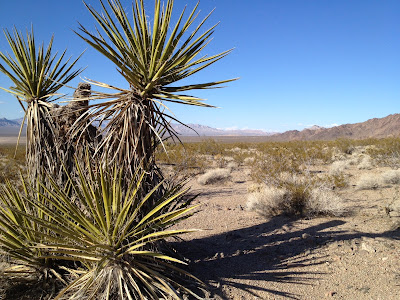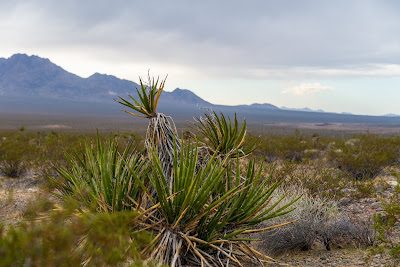Pressure Mounts on First Solar Projects as Ivanpah Recognized As Crucial Tortoise Habitat
More conservation groups have expressed support for preserving desert wildlands in the Ivanpah Valley, an early warning signal that First Solar should back away from their ill-sited solar projects there. Located in the northeastern Mojave Desert and spanning the California/Nevada border, the Ivanpah Valley hosts a robust population of desert tortoises and provides a critical wildlife corridor for this species whose population has declined nearly 90% since the 1980s. Biological surveys and US Fish and Wildlife Service findings increasingly indicate that First Solar is proposing to build in one of the most ecologically sensitive areas of the Mojave Desert, and threatens a level of damage that it cannot buy its way out of with "mitigation" as it did with its other projects.
Basin and Range Watch and a coalition of other desert conservation groups submitted a petition to the Bureau of Land Management (BLM) on 23 October asking that much of the Ivanpah Valley be designated as an Area of Critical Environmental Concern (ACEC). The ACEC proposal argued that additional industrial energy development--including two projects proposed by First Solar--would jeopardize cultural resources as well as important habitat for bighorn sheep, Golden Eagles, several species of rare plants and cut off a corridor that maintains genetic diversity for the threatened desert tortoise by linking different populations.
The Department of Interior later recognized that the Ivanpah Valley serves as an important desert tortoise connectivity corridor when it circulated a draft of its supplement to the solar programmatic environmental impact statement. Under one of the policy options being considered, the Department of Interior would discourage all solar energy projects in areas identified as desert tortoise connectivity corridors. If a company insists on proposing a project in such a corridor, they could not disturb tortoise habitat hosting more than 2 tortoises per square mile, and must maintain habitat connectivity at least 3 miles wide.
Additional Groups Recognize Value of Ivanpah, but silent on First Solar Projects
Other environmental groups weighed in on Ivanpah in January, agreeing that the area is important for wildlife and conservation, although they have stopped short of opposing the First Solar projects that are still pending. The Sierra Club encouraged the Department of Interior to add the Ivanpah Valley to a list of "exclusion areas" that would be off limits to future solar project applications, according to public comment guidelines published on its website in January. The comments did not mention the pending First Solar projects
Other environmental groups signed a joint letter with solar and electric utility companies (posted on the Wilderness Society's website) where the parties -- including First Solar, BrightSource Energy, NRDC, and Southern California Edison--agreed that there should be no future solar project proposals in the Ivanpah Valley. For obvious reasons, the parties do not stipulate in the letter what should happen to the pending First Solar applications, and other language in the letter favors continuation of applications already in process.
 |
| In this photo by Basin and Range Watch, a cluster of Mojave yuccas grow in the Ivanpah Valley where First Solar is proposing to build its massive Silver State South solar power project. |
The Department of Interior later recognized that the Ivanpah Valley serves as an important desert tortoise connectivity corridor when it circulated a draft of its supplement to the solar programmatic environmental impact statement. Under one of the policy options being considered, the Department of Interior would discourage all solar energy projects in areas identified as desert tortoise connectivity corridors. If a company insists on proposing a project in such a corridor, they could not disturb tortoise habitat hosting more than 2 tortoises per square mile, and must maintain habitat connectivity at least 3 miles wide.
Both First Solar projects would violate the best conservation practices being proposed by the Department of Interior in its policy draft:
Three mile wide connectivity corridor: The Silver State South project would be built at one of the narrowest points of the Ivanpah Valley, with less than 3 miles of suitable desert tortoise habitat. Building this solar power project almost certainly would limit the corridor even further, probably to much less than a mile. The Stateline project would also impede the wildlife corridor. The BrightSource project already constrained north/south connectivity on the west side of the Ivanpah Valley, so the negative impacts of the Stateline solar project would be even more profound.
Additional Groups Recognize Value of Ivanpah, but silent on First Solar Projects
Other environmental groups weighed in on Ivanpah in January, agreeing that the area is important for wildlife and conservation, although they have stopped short of opposing the First Solar projects that are still pending. The Sierra Club encouraged the Department of Interior to add the Ivanpah Valley to a list of "exclusion areas" that would be off limits to future solar project applications, according to public comment guidelines published on its website in January. The comments did not mention the pending First Solar projects
Other environmental groups signed a joint letter with solar and electric utility companies (posted on the Wilderness Society's website) where the parties -- including First Solar, BrightSource Energy, NRDC, and Southern California Edison--agreed that there should be no future solar project proposals in the Ivanpah Valley. For obvious reasons, the parties do not stipulate in the letter what should happen to the pending First Solar applications, and other language in the letter favors continuation of applications already in process.
The Road Ahead
First Solar should take notice that it chose poorly when it proposed the Stateline and Silver State projects. Attempting to reconfigure the project boundaries or promise "mitigation"-- conserving tortoise habitat elsewhere as compensation -- simply cannot replace or avoid the fragile connectivity corridor that the Ivanpah Valley offers for the threatened desert tortoise. Furthermore, the abundance of tortoises found in the Ivanpah Valley is a testament to the biodiversity found on this healthy desert habitat. Several species of rare desert plants, raptors, and bighorn sheep -- a richness of rare species assembled in one place that is not found in too many other places in our beleaguered deserts.





And when you add the Desert Xpress high speed rail along with the building of the Ivanpah airport, it will be even more constricted.
ReplyDeleteYou got to love the old Sierra Club trying to have it both ways here as well.
Is this the same First Solar that is headquartered here in Toledo, Ohio? If so, and I assume it is, please let me know, as we would like to network with you and start having actions here to raise local awareness and pressure First Solar to stop destroying dessert habitat. Folks here know nothing of the true nature of the dessert, thinking of it as barren sand. We can use the tortoise as a symbol and get local media attention on this. We also have several friends who are low-level workers for First Solar.
ReplyDeleteRick VanLandingham
shootingsurvivor@yahoo.com